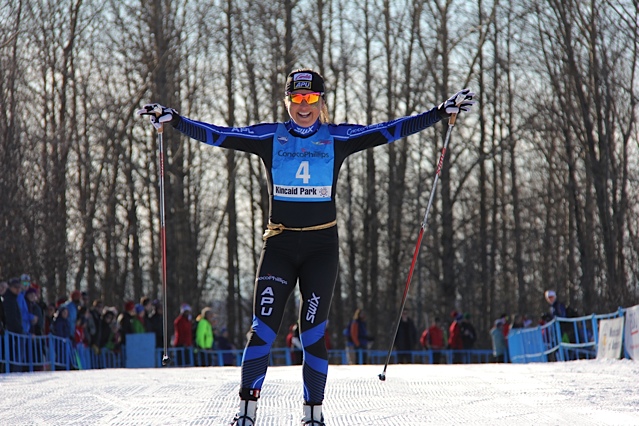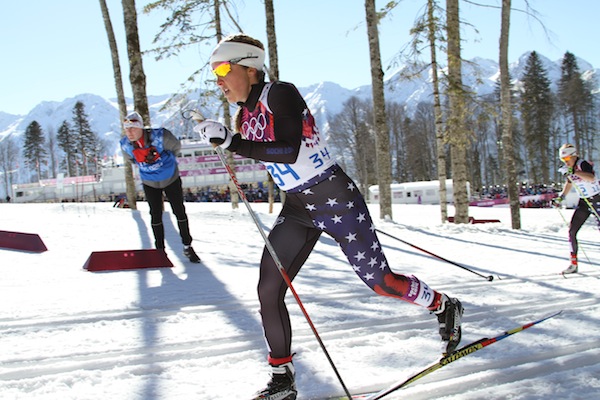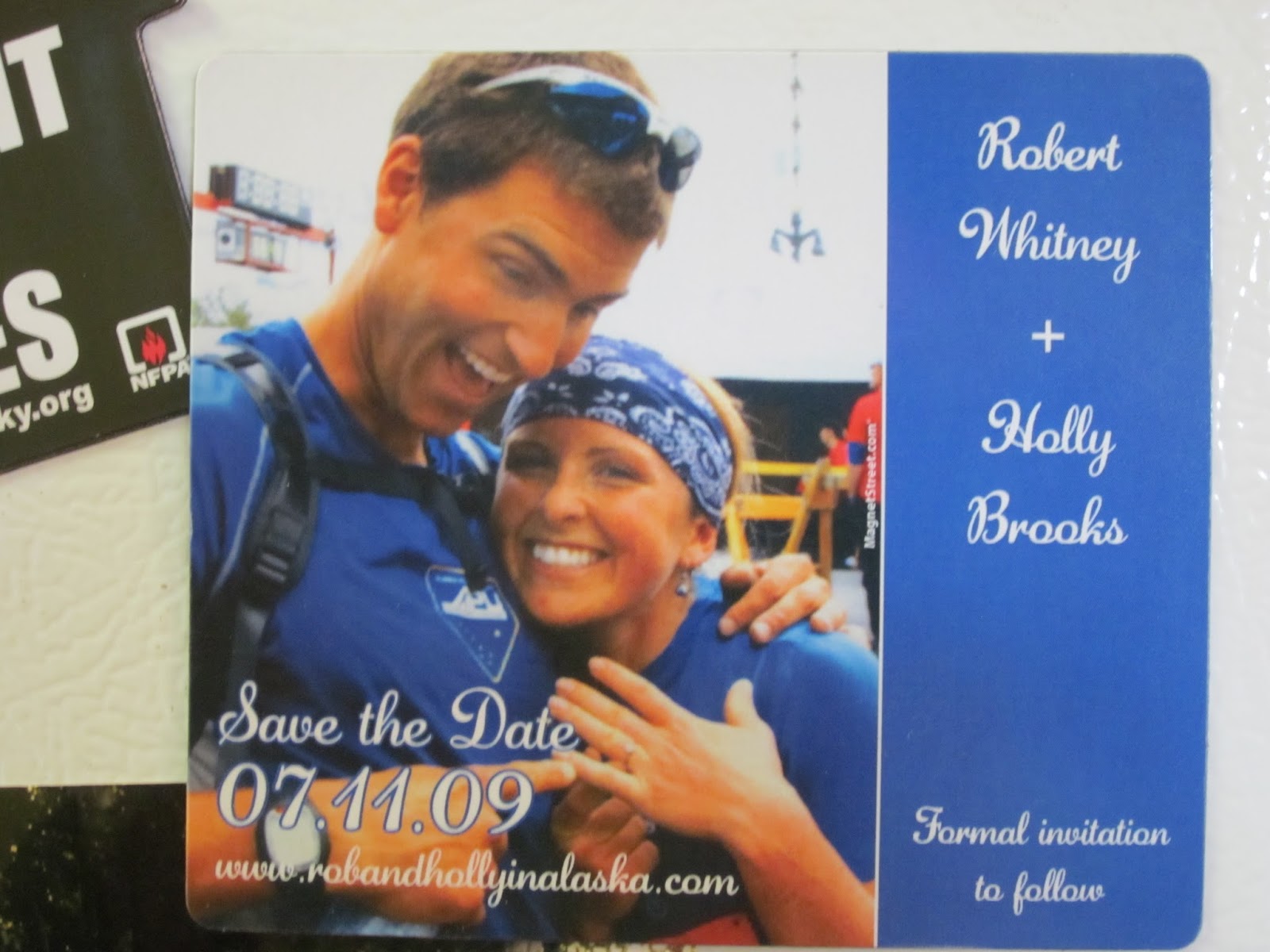
Holly Brooks isn’t retiring. Some people might assume that because, at 32, they think of her as a U.S. Ski Team veteran with two Olympics in the bag — and she wasn’t listed on the recently published U.S. Ski Team (USST) 2014/2015 nominations.
She thinks the veteran misconception is funny considering she’s only been on the national team for two seasons. In a way, she’s just warming up.
On the phone Monday from her cabin in Hope, Alaska, Brooks said that any time someone declines a national-team nomination, or gives their coaches a heads up that they’d like to train and race on their own terms for the upcoming season (like she did this spring), it raises some reactions.

“[One coach] called and left a message that, ‘Wow, that’s a really bold decision, but we support you,’ ” Brooks said with laugh. “I don’t know that they’re entirely surprised, but at the same time it wasn’t something I was openly talking about last season.”
She had been thinking about the possibility for some time and brought it up to women’s coach Matt Whitcomb before leaving Europe in March. She hadn’t made up her mind, but wanted to have some conversations about the possibility of training apart from the national team in 2014/2015.
“[Last] season was definitely my hardest year in a while,” Brooks said. “When I went on this whole role of being an elite skier, I told myself I’d do it as long as I was improving.”
After making the 2010 Winter Olympics while working as a nordic coach at Alaska Pacific University (APU), she spent the next three years competing and feeling like she was steadily improving. Last season, she trained extremely hard and reflected that might’ve been too dedicated, to a fault. This year, she knew something had to change if she wanted to continue.
“I feel like when you take your name out of renomination to the U.S. Ski Team everyone thinks that you’re retiring,” she said. “I just want to do it almost a little on my own terms.”
At the Sochi Olympics in February, Brooks ended the trip to Russia with her career-best Olympic result: 27th in the 30-kilometer freestyle mass start. While a top 30 was something she’d grown accustomed to on the international circuit, it wasn’t the podium or top 10 she continually strived for.
Ask Kikkan Randall, ask anyone on the U.S. team, she said: being on the podium is fun. All of them are competitive, and at that level, medal contention is always the goal.

Brooks came frustratingly close at the Engadin Ski Marathon in Switzerland this year. Fourth in the 42 k skate marathon, she had been in the hunt for first with 15 k to go. A momentary lapse in focus sent her crashing to the ground, and ultimately dropped from the pack. It was a good result nonetheless and hardly the end-all to her season, but it reminded Brooks she wanted more.
“It’s exhilarating being up in the lead pack; that’s something you don’t always feel on the World Cup when you’re not in your top shape,” she said. “Some of these marathons I’d like to go in with a goal of winning. … Not to discount myself, but it’s pretty hard to win a World Cup [and] it’s pretty fun to stand on a podium. I’m excited to have the possibility back in my life.”
In the World Cup’s red group at the end of 2012/2013, an achievement which helped elevate her to the USST A-team last spring, Brooks fell out of it after the first period of 2013/2014. That left her with some “out-of-pocket expenses,” including some lodging, food and travel (FIS covers travel and several nights of room and board for red-group athletes on World Cup weekends, scheduled around the sprint or distance races a given athlete is in the red group for).
Originally planning to skip the Tour de Ski and fly back to the U.S. to train in late December, Brooks stayed in Europe to try to boost her World Cup ranking and qualify for the Olympics. She started the Tour and didn’t finish it, but was able to meet the USST’s objective criteria for Sochi.
In early January, she resumed her plan to take a break and train for two weeks in Park City, Utah. The problem with North American teams on the World Cup circuit, she said, is there’s nowhere to go when you need to get away from the racing scene for a week or two, she said. Even if you’re not competing, you’re still at the race.
“That’s a tough thing that we’re going to have to address,” she said. “The team has talked about how ideally, if the team had this limitless budget, we’d have an apartment [in Europe] where [members] could go and take a rest.”
Until the team finds that amount of money or someone opens their home or part-time residence to them, she said it’ll be a challenge they’ll continue to face.
After getting back up to speed in terms of training and fitness in January, Brooks rejoined the USST in Toblach, Italy, where she scored her first World Cup sprint points of the season (qualifying in 27th and placing 29th overall). From there, she attended the pre-Olympic camp with the team in Seiser Alm, Italy, and went on to compete in three events at the Olympics (15 k skiathlon, 10 k classic and 30 k skate).
She closed out her season with the World Cups in Lahti, Finland, and Drammen, Norway, just before the Engadin in early March. At the end of the month, she raced in front of a home crowd at SuperTour Finals and U.S. Distance Nationals in Anchorage, Alaska.

In the final World Cup standings, she ranked 56th in distance, 76th in sprint, and 84th overall (compared to 27th in distance, 43rd in sprint and 35th overall the year before). She spent a few weeks finalizing her decision regarding her plan for next season, and reached out to her coaches before they met to start planning for 2014/2015.
“It feels funny declining a spot on the U.S. Ski Team,” she said. “I think I may be the oldest person to be named as a rookie … and I worked really hard to be on the team. It feels a little weird to be giving that up, but at the same time … the team in and of itself is fantastic. That’s one of the hard things to step away from … but I’m hoping I can be an honorary member of the team.”
Very much interested in competing in at least a couple marathons next season, perhaps Worldloppets or Ski Classics (and potentially considering joining a European marathon team — or North American-based one if it existed), Brooks, the 2012 American Birkebeiner champion, didn’t rule out aiming for World Cup starts if they’re available.
“I need a little bit of time to come up with my ideal schedule,” she said. “I feel like I haven’t quite had time to settle into my home life.”
USST Head Coach Chris Grover said the decision was entirely hers. “From our perspective, she is invited to every camp that she wants to attend,” he said on Monday. “There will be World Cup opportunities for her; I would not be surprised if she qualified for the [2015] World Championship team.”
That said, with a 2014/2015 national quota of five distance and five sprint spots for the women (to be shared among six women on the USST), it’s not going to be easy to secure those starts.
“Caitlin Gregg and Reese Hanneman have the Period 1 spots locked-up,” Grover explained in an email, referring to the female and male Continental Cup (SuperTour) leaders.
“We may award a start spot at a given World Cup based on the kind of fitness we see in camp this summer and fall, and it will be awarded purely on Coaches’ Discretion,” he added. “We haven’t had the staff resources to cover providing service for invited athletes, so there is a good chance we will ask invited athletes to bring a tech/coach with them. This will be case by case and depends on what the race format is and how many staff we currently have assigned to the WC weekend.”
While Brooks wasn’t sure how many national-team camps she’d attend (not Bend, Ore., in May, but certainly Alaska in July) and whether she’d pursue World Cups by leading the SuperTour circuit early next season, she knew she hadn’t determined which races she wanted to do — or how she wanted her winter to play out.

She had spent some 200 days on the road away from Alaska each of the last several years. She was married, hadn’t seen her brother in four years (until recently), and her sister got married last winter. Instead of catching up with family on the phone during airline layovers, Brooks wanted to see more of her loved ones in person, including her husband, Rob Whitney. A former national-team member, Whitney gave Brooks — a self-proclaimed “mediocre” junior and collegiate skier — the confidence to chase a career in professional racing five years ago.
“He’s been my biggest fan and biggest supporter, but at the same time I think he misses a wife that’s present,” she said. “A funny little analogy that I came up with, it’s a lot like a little deployment. It’s not like war or anything, but you leave for winter and come back. … He’s been the one holding down the fort. I think he’s really excited to spend more time together.”
With the help of his parents, Whitney has spent much of his time building a 1,600-square-foot, wood-heated cabin in Hope, about a 1 1/2-hour drive south of Anchorage. Reminiscent of her family’s cabin in Snoqualmie Pass, Wash., which Brooks used to ski to and from as a child, it’s already larger than their 900-square-foot home in Anchorage, and Brooks was excited to help him finish it. With three acres and wilderness all around them, she said they plan to build some trails and invite friends and the Ski Team to join them there in the future.
The upcoming World Championships in Falun, Sweden, remain high on her list, but Brooks said she’d have to see how financing her ski career and associated travel go. She contacted her sponsors informing them of her decision, and hoped they’d stay onboard.
“I’m hoping that some of my local sponsors still see value in what I’m doing, she said. “I’m going to be able to spend more time in Alaska, and one of my favorite parts about being an elite athlete is being able to give back to the community I live in. If I had to quit skiing and had no sponsorships I’d have to go out and do a traditional job. I wouldn’t have time to do the projects that I’m doing [with the community].”
Brooks will continue to race for APU and one day, she might consider resuming coaching part time. For now, she’s working on earning a master’s degree in counseling psychology at APU, and is about a third of the way through a hefty 60 graduate credits.
“I am looking forward to just having more flexibility with my schedule so I’m probably not going to eight training sessions a week,” she said. “Maybe a little more training with Rob. I think it’ll be a combination of what I think I need to do and I can bounce that off [APU head coach] Erik [Flora] and work in some team sessions as well.”
“She’s a pro,” Grover said. “She, just like the rest of the group, leads by example, trains hard, races hard, is a great competitor — just a positive person and professional athlete. We’ll miss her from the group.”
Come May 19, when the USST starts its first official camp in Bend, Brooks said she won’t necessarily miss training on snow. But she knows she’ll miss the team.
“I don’t think it’s really set in that I’m not on the team, but I think on May 19 that will set in,” she said. “I know in advance that’s going to be really hard. I love my teammates …I’ll miss them but I’ll see them in Alaska.”
Alex Kochon
Alex Kochon (alexkochon@gmail.com) is a former FasterSkier editor and roving reporter who never really lost touch with the nordic scene. A freelance writer, editor, and outdoor-loving mom of two, she lives in northeastern New York and enjoys adventuring in the Adirondacks. She shares her passion for sports and recreation as the co-founder of "Ride On! Mountain Bike Trail Guide" and a sales and content contributor at Curated.com. When she's not skiing or chasing her kids around, Alex assists authors as a production and marketing coordinator for iPub Global Connection.



